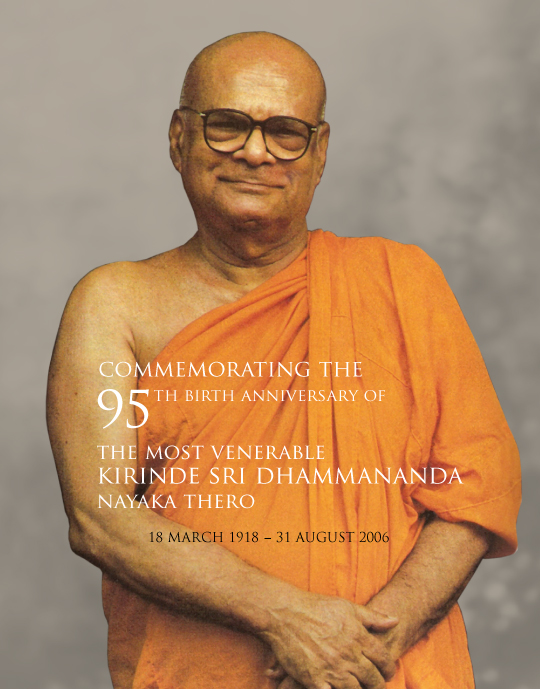Sangha Nāyaka of Malaysia
Sangha Nāyaka of Malaysia
Nalanda Patron’s Day will be observed over 3 days from 16 – 18 March, with a wholesome line-up of meaningful educational programmes. 18 March 2013 marks the 95th birth anniversary of our late Spiritual Advisor, Venerable Kirinde Sri Dhammananda. The late venerable was an erudite monk fondly known as the “Sangha Nāyaka of Malaysia”.
Sri Lankan Monastic Lineages
In Sri Lanka, there exists 3 main Theravadin Sects, namely the majority Siyam-Upali (or Siam-Nikāya), Ramañña-Nikāya, and Amārapura-Nikāya. These refers to the reintroduction of ‘Upasampada‘ (bhikkhu ordination) back to Sri Lanka after a period of general decline in Buddhist fortune during the Portuguese and Dutch colonial periods. Siam-Nikāya refered to the Theravāda lineage re-introduced to Sri Lanka from Thailand. Whereas Ramañña and Amārapura were Theravāda lineages brought over from Burma.
These 3 sects are further divided into many ‘chapters’, centred around important or popular monasteries. Under the Siam-Nikāya, there are the bigger Malwatta and Asgiri Chapters based in Kandy, among others. However, there are no doctrinal differences between the 3 Theravadin sects in Sri Lanka. The difference is in their ordination lineage.
Bestowing Titles
Titles such as “Sangha Nāyaka” are often bestowed upon overseas Sinhalese monks to honour their role in propagating Buddhism in distant lands. These titles were no doubt in recognition of their individual contribution and services to the Buddha-Sāsana outside their motherland, and are understandably a matter of personal and social prestige to Sinhalese Buddhists. However, such titles are purely honorific, much like an honorary doctorate, and carry no extra ‘jurisdiction’ or ‘authority’. They are also not “offices” and cannot be inherited by other monks upon the death of their title-holders.
Very often, several individual Sinhalese monks can be honoured with similar titles of “Sangha Nāyaka“, such as in the case of Malaysia, Singapore, the USA, the UK, Canada, et cetera. It must further be clarified that these titles are only bestowed upon the Sinhalese Sangha, and thus is communal by nature, and are by no means universally ‘recognised’ by other Theravadins or Buddhists in general.
The Thai Sangha in Malaysia has its own ‘hierarchy’ of honorary monastic titles. However, the local Malaysian Theravāda Sangha has no such practice of ‘bestowing titles’. The usual way a local monk is addressed is with the very unassuming honorific ‘Ayasma’ (or ‘Venerable’ in English). If he has been a monk for more than 10 years, his bhikkhu (monastic) name may sometimes be respectfully tagged with the term ‘Thero’, meaning an ‘Elder’.
Venerable K. Sri Dhammananda
Our late Spiritual Advisor, Venerable Kirinde Sri Dhammananda, was bestowed an honorary title by a Sri Lankan monastic chapter back in 1965. He was much respected for his vast knowledge and erudition, and loved for his joviality. He was warmly referred to by many as “Chief“, not so much because of his ‘title’, but because of his affable character and commanding personality. Even when he was alive, there were other senior “Sangha Nāyakas” around, such as Ven. Pandit Sri Pemaratana of Penang.
After Ven. Dhammananda passed away, his honorific title “Sangha Nāyaka” could not be inherited by anyone, simply because it was not a position or an office. It must be clearly stated that no such “office of the Sangha Nāyaka of Malaysia” exists, nor is it recognised at all in the Vināya – which is the monastic code governing all Buddhist monks.
Many devotees had a personal encounter with the late Venerable Dhammananda regarding his ‘position’ as “Sangha Nāyaka“. The erudite venerable unassumingly answered, “The Buddha only taught us to ‘master one’s own mind’. How can one be ‘chief‘ to other people? One’s own mind is the ‘chief‘!” Though Venerable Dhammananda took his ‘title’ in stride, he never really seemed to have taken it too seriously!


